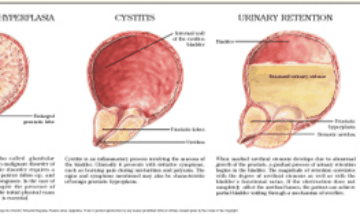Amid the range of treatment options, there are several instances in which patients with prostate problems including Enlarged Prostate (BPH) might require surgery. The major concerns that may lead to surgery are:
 When a patient has the inability to urinate. Testing is done with a catheter tube entered into the urethra until it reaches the bladder to be able to flush out the urine. If that does not work, actual surgery may be required.
When a patient has the inability to urinate. Testing is done with a catheter tube entered into the urethra until it reaches the bladder to be able to flush out the urine. If that does not work, actual surgery may be required.- When the urethra is blocked. This is a risk for urinary tract infection, bladder stones and general bladder damage.
- When the presence of blood in the urine can not be treated with medication.
- When kidney damage has developed.
However even in the absence of specific symptoms typical of Enlarged Prostate (BPH), surgery may be chosen to deal with discomfort when other approaches have not rectified the problem.
It May Be Helpful To Consider:
- Is there sufficient reason to expect that the surgery will diminish or resolve the problem?
- To what extent do prostate enlargement or other prostate issues cause problems?
- Is there a potential for complications or post-surgery issues?
Typically, surgical methods for Enlarged Prostate (BPH) are less invasive. Transurethral surgical procedures use instruments specially designed for insertion into the urethra until reaching the prostate.
Transurethral resection
 Transurethral resection (TURP) is the most extensively used surgical procedure to treat Enlarged Prostate. The surgery is used to remove prostate tissue.
Transurethral resection (TURP) is the most extensively used surgical procedure to treat Enlarged Prostate. The surgery is used to remove prostate tissue.- Other less frequently used procedures to treat prostate problems are:
- Transurethral Incision of the Prostate (TUIP) which uses an incision to widen the opening and release pressure
- Transurethral Laser Vaporization or Transurethral Laser Coagulation where a laser creates an incision in the prostate allowing the release of pressure
- Transurethral Microwave Therapy where microwaves are directed to destroy tissue in the prostate and some adjoining areas
- Transurethral Needle Ablation where a hot needle destroys tissue in the prostate and some adjacent areas
These procedures are in more recent stages of development, and their application is still being studied.
A more common procedure is the open prostatectomy in which the surgeon gains access to the prostate through an incision, to regulate the condition and reduce or eliminate discomfort. Patients with severe Enlarged Prostate (BHP) are commonly given this course of treatment.
Things To Keep In Mind:
 While there is a range of approaches to treat Enlarged Prostate (BHP) and other prostate problems, surgery still offers the best rates of success.
While there is a range of approaches to treat Enlarged Prostate (BHP) and other prostate problems, surgery still offers the best rates of success.
The type of surgery depends on the level of enlargement and the general condition of the prostate. But even these cannot always guarantee a complete solution to the problem and some symptoms may persist.
While most patients experience improvement and relief because of the surgery, secondary issues after surgery may also be present. These include impotence, incontinence, and retrograde ejaculation, where semen is directed into the bladder instead of the penis. These are factors to consider in the choice of treatment.











